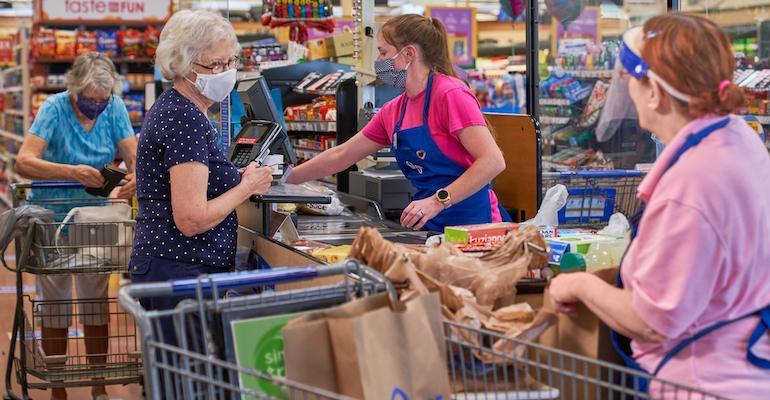By Russell Redman
Source: www.supermarketnews.com, August 2021
Grocery retailers could be in for another wave of consumer stockpiling as COVID-19 infection rates climb nationwide due to the rapid spread of the Delta variant, new research from Inmar Intelligence shows.
Of 1,000 U.S. adults surveyed, 69.4% said they’re considering replenishing a current stockpile of groceries and other essential products as transmission of the Delta variant increases, Inmar said in the study, released this week. Forty-six percent have created a product stockpile in response to coronavirus, and 12% of those that haven’t done so said they now will stock up because of the Delta variant. Another 32.8% said they’re not sure if they will build up their supplies.
“We have all lived with uncertainty during the pandemic for over a year now. We thought we were heading in the right direction, but now there is another surge with the Delta variant that is making consumers nervous once again,” Holly Pavlika, senior vice president of corporate marketing at Inmar, said in an email on the July 30 survey’s findings.

Sixty percent of consumers polled reported still having products in stockpile they created because of the COVID-19 outbreak, Winston-Salem, N.C.-based said. Looking ahead, an even higher percentage of respondents — 65% — said they now plan to always have a stock of food and supplies for emergencies like the pandemic. Another 15.7% weren’t sure if they will create an emergency supply going forward.
About 27.9% of shoppers surveyed said they’re considering the creation of a stockpile because the fast spread of the Delta variant has them worried about going to the grocery store. Other concerns spurring consumers to stockpile included rising prices (cited by 18.1%), low on current supplies (19.1%) and the possibility that products they want won’t be available when needed (27.9%).

Nearly three-quarters of those polled (74.7%) reported they currently encounter product shortages when shopping.
“Beyond the fear of stepping outside their home to grocery shop, 30% of respondents said they’re stockpiling because they’re concerned that the products they need will be out of stock, and 18% are worried that prices will go up,” Pavlika said. “All in all, we have created a new shopper segment: ‘the Squirrel,’ who will always have a stash in their home.”
Media coverage of COVID-19 and other current events (rising gas and consumer pricing, politics, crime, natural disasters, etc.) has swayed many Americans to stock up on food and key supplies, Inmar’s survey revealed. Half of respondents said media reports “fully influence” their stockpiling decisions, while 34.6% said the news “somewhat influence” their decision to stock up. Recommendations from family (64.6%) and friends (52.2%) have led shoppers to create a stockpile as well. Consumers also said co-workers (25.9%) and social media posts (34.8%) have nudged them to stock up.

Up-and-down COVID-19 infection rates around the country and vaccine hesitancy among many Americans, too, are pushing consumers to restart stockpiling, according to Pavlika. Only about half of the total U.S. population is fully vaccinated against the virus, Centers for Disease Control and Prevention (CDC) data show.
“COVID [transmission] has certainly played a large role in this, starting with the early days when shoppers went to stores to find many shelves empty and, in some cases, those shelves have not returned to pre-pandemic supplies,” she explained. “Many Americans are also concerned that not everyone is vaccinated in stores, particularly older consumers or those who already have health issues.”
Among products already in or slated to be added to a stockpile, consumers cited toilet paper (72.1%), hand sanitizer (62%), paper towels (54.6%), soap (50.4%) and disinfecting wipes (49.7%). Other products in shoppers’ current stockpile or expected to purchased included canned goods (46%), medical supplies (44.3%), tissues (41.3%), pet care (36.8%), pasta (34.1%), beer/wine/liquor (22.8%) and baby care (18%).
Inmar said items in consumers’ next round of stockpiling that weren’t in their first include frozen foods, shelf-stable foods, face masks, bottled water, plastic plates/cups, meat, fresh produce, ice cream, candy, soda, personal care products, laundry detergent, vitamins, candles, first aid, batteries and portable chargers, and seeds for growing their own food.
In buying products to stockpile, about the same percentage of consumers said they will go to stores (46.4%) or shop online (46.6%). About 21% of online shoppers plan to use curbside service.
Though the arrival of COVID vaccines and relaxation of restrictions has led more consumers and slowed growth in online grocery purchases, the pandemic has reinforced an omnichannel mindset in shoppers, according to Pavlika.
“Our research has shown that the hybrid shopper is here to stay. Research we did in early July showed that 86% of respondents said they’ll return to in-store grocery shopping, while a remaining 14% said they would not because they won’t feel safe or don’t have the time to go to stores,” she said. With the hybrid shopper, they choose what channel fits their needs at the moment. Convenience has always been the No. 1 desire from shoppers.
“The spread of the Delta variant will most likely affect shopping behavior in those geographies that are experiencing huge spikes,” Pavlika added. “Mask mandates will most likely be the norm for the foreseeable future until we get this under control. And with uncertainty, online grocery sales will likely experience an uptick.”

